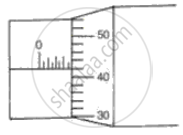Advertisements
Advertisements
Question
Explain the terms : Pitch .
How are they determined?
Solution
Pitch : The pitch of a screw gauge is the distance moved by the screw along its axis in one complete rotation.
APPEARS IN
RELATED QUESTIONS
Define metre according to the old definition.
(a) A vernier scale has 20 divisions. It slides over the main scale, whose pitch is 0.5 mm. If the number of divisions on the left hand of the zero of vernier on the main scale is 38 and the 18th vernier scale division coincides with the main scale, calculate the diameter of the sphere, held in the jaws of vernier callipers.
(b) If the vernier has a negative error of 0.04 cm, calculate the corrected radius of the sphere.
A micrometre screw gauge has a positive zero error of 7 divisions, such that its main scale is marked in 1/2 mm and the circular scale has 100 divisions. The spindle of the screw advances by 1 division complete rotation.
If this screw gauge reading is 9 divisions on the main scale and 67 divisions on the circular scale for the diameter of a thin wire, calculate
- Pitch
- L.C.
- Observed diameter
- Corrected diameter
A micrometre screw gauge has a negative zero error of 7 divisions. While measuring the diameter of a wire the reading on the main scale is 2 divisions and 79th circular scale division coincides with baseline.
If the number of divisions on the main scale is 10 to a centimetre and circular scale has 100 divisions, calculate
- pitch
- observed diameter
- least count
- corrected diameter.
What do you understand by the following term as applied to micrometre screw gauge?
Thimble scale
Explain the term least count of a screw gauge. How are they determined?
What is meant by the pitch of a screw gauge? The pitch of a screw is 1 mm.
Find the reading of the instrument shown in the following figure.

